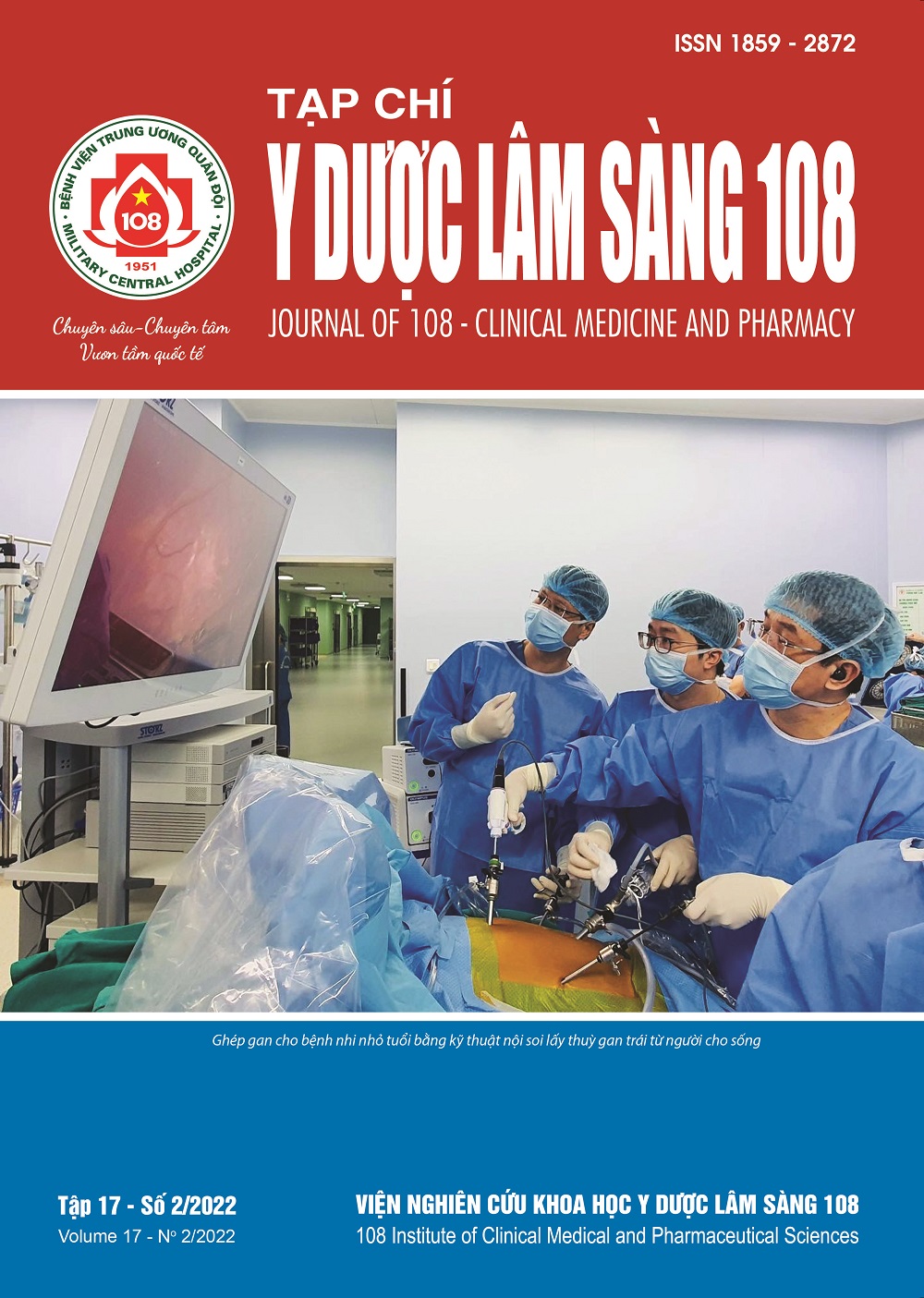Tỷ số apolipoprotein B/A-I và mối liên quan đến xơ vữa hẹp, tắc động mạch trong sọ ở bệnh nhân nhồi máu não
Main Article Content
Keywords
Tóm tắt
Mục tiêu: Đánh giá nồng độ apolipoprotein A-I, apolipoprotein B huyết tương, tỷ số apolipoprotein B/A-I theo tình trạng xơ vữa động mạch não. Xác định giá trị tiên lượng xơ vữa hẹp, tắc động mạch trong sọ bệnh nhân nhồi máu não của tỷ số apoB/apoA-I. Đối tượng và phương pháp: Gồm 248 bệnh nhân nhồi máu não điều trị nội trú tại Trung tâm Đột quỵ não - Bệnh viện Trung ương Quân đội 108 từ tháng 10/2017 đến tháng 12/2019 và được chia thành 2 nhóm: Nhóm nhồi máu não do xơ vữa mạch máu lớn có 146 bệnh nhân và nhóm nhồi máu não do tắc động mạch nhỏ gồm 102 bệnh nhân. Phương pháp nghiên cứu tiến cứu mô tả cắt ngang. Bệnh nhân nhồi máu não vào viện được khám lâm sàng, chẩn đoán hình ảnh, xét nghiệm. Kết quả: Nồng độ apoB, tỷ số apoB/apoA-I của nhóm bệnh nhân xơ vữa hẹp, tắc động mạch trong sọ cao hơn của nhóm xơ vữa hẹp, tắc động mạch ngoài sọ có ý nghĩa thống kê với p<0,05 (1,34 ± 0,3g/l so với 1,22 ± 0,27g/l, 1,19 ± 0,33 so với 0,97 ± 0,35). Nhóm hẹp, tắc 1 vị trí có nồng độ apoA-I cao hơn; nồng độ apoB, tỷ số apoB/apoA-I thấp hơn nhóm hẹp tắc nhiều vị trí có ý nghĩa thống kê với p<0,05 và p<0,01. Nồng độ apoB, tỷ số apoB/apoA-I thấp nhất ở nhóm hẹp vừa rồi đến nhóm hẹp nặng và cao nhất là nhóm tắc mạch. Có mối tương quan nghịch giữa nồng độ apoA-I (r = -0,34, p<0,01), mối tương quan thuận giữa nồng độ apoB (r = 0,35, p<0,01), tỷ số apoB/apoA-I (r = 0,41, p<0,01) với % hẹp lòng mạch. Phân tích đa biến nhóm nhồi máu não do xơ vữa hẹp, tắc động mạch trong sọ: Tỷ số apoB/apoA-I có OR = 3,543, KTC 95% (1,074 - 11,632), p<0,05. Giá trị cắt là 0,965 (độ nhạy: 63%, độ đặc hiệu: 55%). Kết luận: nồng độ apolipoprotein A-I, apolipoprotein B huyết tương, tỷ số apolipoprotein B/A-I có sự thay đổi theo tình trạng xơ vữa động mạch não. Tỷ số apoB/apoA-I là yếu tố tiên lượng độc lập xơ vữa hẹp, tắc động mạch trong sọ bệnh nhân nhồi máu não.
Article Details
Các tài liệu tham khảo
2. Wang Y, Zhao X, Liu L et al (2014) Prevalence and outcomes of symptomatic intracranial large artery stenoses and occlusions in China: The Chinese Intracranial Atherosclerosis (CICAS) study. Stroke 45(3): 663-669.
3. Schmidt C, Wikstrand J (2009) High apoB/apoA-I ratio is associated with increased progression rate of carotid artery intima-media thickness in clinically healthy 58-year-old men: Experiences from very long-term follow-up in the AIR study. Atherosclerosis 205: 284-289.
4. Park JH, Hong KS, Lee EJ et al (2011) High levels of apolipoprotein B/AI ratio are associated with intracranial atherosclerotic stenosis. Stroke 42: 3040-3046.
5. Adams HP, Bendixen BH, Kappelle LJ et al (1993) Classification of subtype of acute ischemic stroke. Definitions for use in a multicenter clinical trial. TOAST. Trial of Org 10172 in Acute Stroke Treatment. Stroke 24(1): 35-41.
6. Owen BS, Gregg JJ, Michael JL et al (2000) A standardized method for measuring intracranial arterial stenosis. American Journal of Neuroradiology 21(4): 643-646.
7. U-King-Im JM, Trivedi RA, Cross JJ et al (2004) Measuring carotid stenosis on contrast-enhanced magnetic resonance angiography: Diagnostic performance and reproducibility of 3 different methods. Stroke 35(9): 2083-2088.
8. Li MM, Lin YY, Huang YH et al (2015) Association of apolipoprotein A1, B with stenosis of intracranial and extracranial arteries in patients with cerebral infarction. Clin Lab 61(11): 1727-1735.
9. Fahmy EM, El Awady MAE, Sharaf SAA et al (2020) Apolipoproteins A1 and B and their ratio in acute ischemic stroke patients with intracranial and extracranial arterial stenosis: An Egyptian study Ebtesam Mohammed. Egypt J Neurol Psychiatry Neurosurg 56: 115.
10. Sun Y, Hou XH, Wang DD (2019) Apolipoprotein B/AI ratio as an independent risk factor for intracranial atherosclerotic stenosis. Aging (Albany NY) 11(17): 6851-6862.
11. Cuomo S, Guarini P, Gaeta G et al (2002) Increased carotid intima-media thickness in children-adolescents, and young adults with a parental history of premature myocardial infarction. Eur Heart J 23(17): 1345-1350.
12. Hamsten A, Walldius G, Szamosi A et al (1986) Relationship of angiographically defined coronary artery disease to serum lipoproteins and apolipoproteins in young survivors of myocardial infarction. Circulation 73(6): 1097-1110.
13. Yang WS, Li R, Shen YQ et al (2020) Importance of lipid ratios for predicting intracranial atherosclerotic stenosis. Lipids in Health and Disease 19: 160.
 ISSN: 1859 - 2872
ISSN: 1859 - 2872
